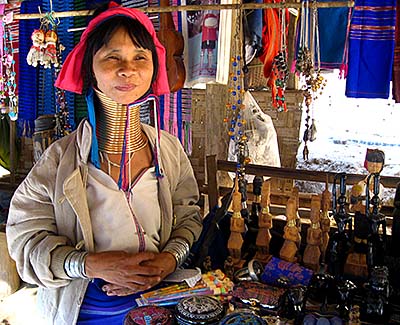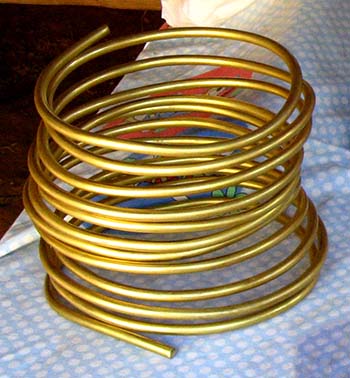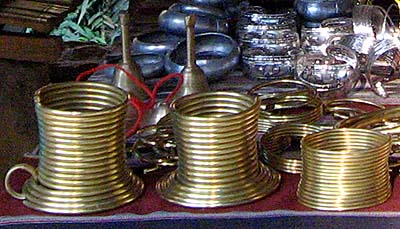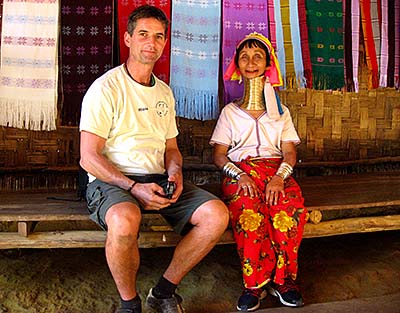1.
Nai Soi Refugee Village
Nai Soi in Mae Hong Son Province is a tribal village. It's inhabitants are war refugees from closeby Burma/Myanmar. Of the 1,800 inhabitants are best known the Kayan Lahwi People, a clan of the Red Karen People. Their fame rests on the old custom of the Kayan women to wear large brass spirals around their necks. Other village inhabitants here are Shan People.

A young Kayan woman in a souvenir shop in Nai Soi. Image by Asienreisender, 2/2007
There is a number of refugee villages in Mae Hong Son Province, but Nai Soi is certainly the most famous of it's kind in whole Thailand, for it has become a tourist attraction. There are about 1,200 annual touristic visitors coming to Nai Soi, who pay an entrance fee of 250 baht each. The village women make some money by selling souvenirs, that are accessoires of the tribal culture like cloths, clothes, jewelry, statues, carvings and other items.
Where the entrance fees are going is a very secret, as it is actually far too often such cases (see for example the Multi Million Dollar Business in Angkor Archaeological Park). It's said, the entrance fees are shared by the touristic managers, by Thai administrative functionaries and the buerocracy and the Karenni National Progressive Party. One has to keep in mind that the Karens are in a state of war with the Burmese regime. The little money from the sales are kept by the families who run the shops.
Nai Soi village is about 20km away from Mae Hong Son town. There is another village, Ban Mai Nai Soi Karenni refugee camp, 3km from Nai Soi, which is much larger but no tourist attraction. There are around 20,000 people living.

The dwellings of Ban Nai Soi are typical for the way the hill tribes use them. Appart from the corrugated iron used for the roof, it's very traditional and was to see ten years ago very often all around in the Greater Golden Triangle. More and more, and very quickly, these houses are replaced by new ones, build in concrete bricks, who last longer and give more protection against the weather. Image by Asienreisender, 2/2007
2.
Kayan People
The Kayan People (also Kekawngdu) are a people from southeast Burma. There is also the term Padaung, what is a name the Shan have given the Kayan because of the brass spirals the women wear around their necks. However, although the term Padaung is used by Burmese and Thai, the Kayan don't use it themselves. The names Longneck Karen or Giraffe Women are considered as insulting.

A Kayan Lahwi woman in Nai Soi. Image by Asienreisender, 2/2007
The Kayan, as a subgroup of the Karen, consist of four clans. The women of the different clans are distinctive by the kind of their jewelry. Only the Kayan Lahwi Clan has the habit of the neck brass coils.
The origins of the Karen lies in south China and Tibet. Ethnologists assume that the migration of the Karen into what is nowadays Burma and west Thailand happened already more than a thousand years ago. The Kayan themselves date their migration to 769 CE. It was insofar the first wave of Sinotibetian people migrating into Southeast Asia, what was at the beginning of history dominated by Indian ethnics like the Mon and Khmer. Might be they initially were avoiding conquest and slavery by the expanding Han Chinese at around 0 CE. Their first destination then were the mountains of Tibet, only several centuries later they went down, wandering further south.
The home land of the Kayan People in Burma is a mountainous terrain in the altitudes between 1,000 and 1,500 meters above sea level. The extension of the small Kayah State is about 400km2, west of the Salween River and south of Loikaw, what is called the capital of the Kayan.

A Kayan woman, cooking outdoors. Not seldom one sees here still also the brass coils around the legs. Image by Asienreisender, 2/2007
The specialization of the Kayan to the highlands includes a picturesque terraced agriculture for rice and vegetables with a very sophisticated irrigation system. Besides rice, bananas and corn they cultivate cotton, what is the raw material for their clothing. For hunting they use trained dogs to catch pigs, fowls and more.
The Kayan are a clan society, what means that marriages have to happen within the clan, not involving outsiders. Marrying a non clan member means the exclusion of the community.
Oral transmission and some other indices imply a former tradition of matriarchy. In times of tribal feuds, centuries ago, the loss of men in fightings was so high that polygamy was introduced. However, also this chapter is history, and since a long time the Kayan live monogamous.
The religion of the Kayan Lahwi People is traditionally animistic. They believe in countless spirits and demons. Most of the ghosts are bad minded and get sacrifices in form of food, drink and more. Sometimes livestock get's sacrificed for the spirits. In other cases village ghosts are driven out of the village by the locals making a great din. Interestingly, it's believed that the spirits of deceased people are particularly bad and evil.
Shamans and fortune telling are an important part of live. The shamans analyze dreams or signs in the nature. The blood of a sacrificed animal gives hints of what's coming in the future. Most popular is fortune telling by reading the truth out of chicken bones.
In the 19th century Christian missionaries visited Kayan tribes and partially converted whole villages to Christianity. Other Kayan converted to Buddhism. Nevertheless, despite the acceptance of these world religions, Animism still plays a central role. That is so, by the way, to say for most of the People of Southeast Asia.

More dwellings of Ban Nai Soi. Images and photocomposition by Asienreisender, 2007, 2016
3.
The Brass Necklace Coils
The most eye-catching peculiarity of the Kayan Lahwi are the women's necklesses. This custom is, as it is said, about a thousand years old. There are many rumours around about that, of who I want to pick up some. First, the supposed rings around the neck are no rings; it's a spiral, means it's one piece of metal. The brass spiral get's adapted by another woman, turn for turn wound around the neck, often 30cm or 40cm high. In the past other metals like gold, silver or copper were also used.

A brass coil in Ban Nai Soi. Image by Asienreisender, 2/2007
It was for long an open question how it could possibly be that the neck of the Kayan women could get so stretched. A definite answer gave the American Dr. John M. Keshishian in 1979, applying x-rays of the women's necks. The result showed that, surprisingly, the vertebras weren't expanded at all. On the contrary, the heavy weight of the spiral pushed the shoulder belt and collar bones down, affecting also the upper ribs. This deformation gives only the optical illusion of a long neck.
There is also the legend of the spirals as a tiger bite protection. Tigers have the habit to attack their prey by a lethal bite into the neck. I observed that, by the way, by my housecats already. They use the same technique when, for example, attacking and killing a chicken chick from the neighbours. What they shouldn't do, but I can't stop them, and the owners don't care. However, the Kayan women themselves say that wouldn't be the reason for the tradition.
A more probable explanation is the application of the necklaces as a mean against rapes and the hijacking of the women by other tribes. The necklace and the deformation would make the women unattractive for outsiders. Later, the necklace was seen as a kind of a magic amulet.
The necklace ritual starts when a girl is about five years old. A shaman asks the chicken bone oracle for an appropriate day for the act. A celebration happens. After two, three years due to the growth of the child, the spiral gets replaced by a larger one. At the age of 15 the girl get's additionally to the neck spiral a shoulder spiral, which overlaps the other one in the lower part. The application of the spirals takes several hours. The coil of an adult woman is about 20 to 25 turns, what is about 30cm or more in height.

Some more of the kind. Image by Asienreisender, 2/2007
So, a fully developed necklace can weight up to 10kg, and, as it was in the past, armor on arms and legs weight additionally 15kg to 20kg. It's a huge burden and impairs the freedom of movement. Swallowing and hygiene are impaired by it. Nevertheless, the women are responsible for field work, preparation of food, bringing water from the well or river and shopping on the local market. They bring the children up also, although the Kayan men have the reputation to support their women much in that.
The necklace must be a huge burden in the hot and often dump climate. It seems easier to them to turn the whole chest instead the head only. Sometimes, the women's voices sound low. Nevertheless, it has no impact on their live expectency.
Discarding the neckless for certain reasons makes the hanging shoulders visible. The skin is pressed and looks squeezed and unnatural. Due to the supporting attribute of the spiral, the neck's muscles are weakened and there is the danger of breaking the neck under charge or when falling. Getting rid of the heavy weight makes the women feeling strange at the beginning. The neck's muscles will recover relatively quickly, though, but the deformation of the skeleton is irreversible.
Nowadays, it happens that some Kayan women don't apply the tradition anymore. Additionally to the necklaces there were also jewelries for the legs applied, what is nowadays rather rarely the case. Generally, as we see it in our times almost everywhere, detraditionalization leads to the abolishment of old customs. In our case, many of the women of Nai Soi apply the neckless still merely for economic reasons. It sells in tourism.
4.
Tourism in Nai Soi

The very kind and open-minded Kayan woman is patiently answering some tourists questions. Image by Asienreisender, 2/2007
In precolonial times already were the Kayan Lahwi women an attraction for the Burmese nobility in Mandalay. In the colonial times they gained attention among the British and some were even brought to England and presented in the freak show of Bertram Mills Circus. There was a Kayan tourism already in Burma in the 1950s, when people visited the villages just for the reason to see the blazoned women.
After the military coup of general Ne Win in 1962, the civil war in Burma got worse and the Kayan State was no more accessible for tourists. Kayan Lahwi women were still hijacked and brought to other parts in Burma to run the show business. As a reaction of the war, many Kayan crossed the border to Thailand.
The commercialization of the Kayan in Mae Hong Son Province started in the late 1980s in one of the first Kayan tourist villages. In comparison with the miserable situation in Burma/Myanmar it seems to be the better option, but still do the people suffer deprivation. The tourist impact alone is altering the social life of the people considerably.

A sign to Ban Nai Soi in Thai and Western script. Image by Asienreisender, 2/2007
There is criticism on the marketing of the Kayang, and sometimes villages like Nai Soi, of who are alltogether eight in Thailand, are called 'human zoos'. The government of New Zealand and other states granted years ago the Kayan Lahwi People political asylum, but the Thai government didn't allow them to leave Thailand - with the hypocritical argument that all refugees have to be treated equally. In 2008, they made some exceptions after some international pressure.
The village of Nai Soi is seen as a self-sustaining refugee camp by the Thai authorities and as a source of income.
In fact, the Kayan Lahwi are under severe restrictions to leave the village or the district. The refugees are not allowed to take regular jobs - they have no working permits and can not travel freely. Adults and kids are (illegally) leaving the villages trying to find jobs in field work around the village, and if they find work they do it for a miserable wage. Often they are even bereaved of the promised 50 baht (for females) or 60 baht (for men, 60 baht are about two dollars) salary. Refugees are particularly vulnerable for exploitation, and the business world is based on the exploitation of labour in general.
A great number of the children and adolescents in the village and the nearby camp have never experienced another life than that in the camp. The poor economic situation and the limited live experiences deprive the children from a satisfactory development of their potentials, skills and visions. Many villagers suffer from mental disorders due to traumatic experiences in the last years as forced relocation, hiding in the jungle, the destruction of their villages or having been raped. They have depressions, anxiety and post-traumatic stress disorders.